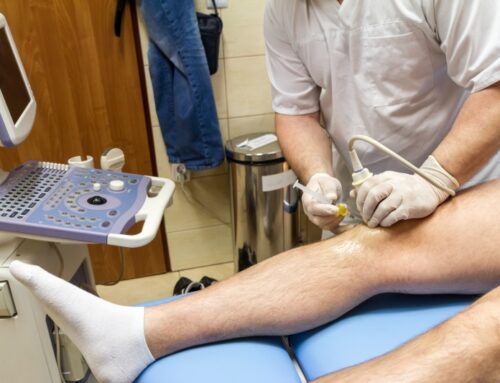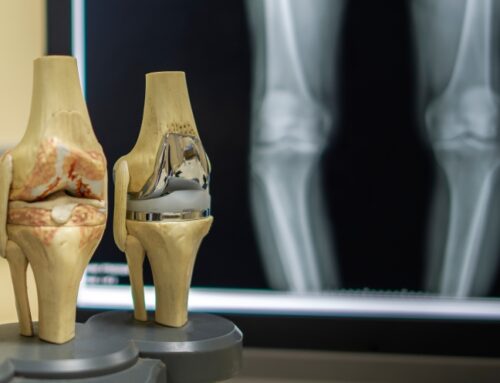The plantar fascia is a strong fibrous band between the heel and forefoot and helps support the ankle and foot arch. Injury to the plantar fascia is common in elite athletes or weekend warriors. Swelling of the plantar fascia, also known as plantar fasciitis or heel spurs, is often managed with simple treatments such as stretching and massage. However, complex cases might need a plantar fasciitis injection. So, is a plantar fascia ultrasound injection worth it?
What are the typical features of plantar fasciitis?
Plantar fasciitis is throbbing or burning pain at the inside part of the heel. Pain is gradual over weeks to months, although it sometimes occurs suddenly. The pain worsens in the morning or at the beginning of an activity. Also, continuous movement, such as walking or running, can improve it.
How do we diagnose plantar fasciitis?
Firstly, an assessment by a doctor is often enough. For example, a history of warming up heel pain and tenderness at the heel is typical. Secondly, it is essential to find factors that have led to an injury, such as training errors, muscle tightness, or weakness in the lower legs.
Generally, imaging assists in the diagnosis. Usually, ultrasound is the first choice to detect typical swelling changes and thickening of the plantar fascia. It can also exclude other conditions, such as plantar fibroma. On the other hand, MRI is used for complex cases or when we think pain is due to other causes, such as bone stress fractures or cysts.
What is the treatment of heel spurs?
Most cases will improve with a simple treatment of rest, stretching, and foot strengthening exercises. Rolling the plantar fascia with a tennis or golf ball may help. A simple insole for your shoes is helpful for support. A recent study on the treatment of plantar fasciitis found that rest, self-monitoring of pain, suitable footwear, and stretching successfully relieved pain.
Generally, taping of the heel is effective at reducing heel spur pain. We use two types of taping – low dye and calcaneal taping. Also, we find night splints effective.
What do you do if these simple measures fail?
It is essential to see a doctor to make the correct diagnosis for stubborn cases.
In addition, referral to a therapist for exercise is beneficial. For example, calf raises on a step usually improve pain. Furthermore, a podiatrist can help with shoe selection and orthotics. However, we don’t know whether the more expensive casted orthotics are better than cheaper off-the-shelf orthotics.
Shockwave therapy (ESWT) is effective for troublesome plantar fasciitis. We think shockwave works by sending a sound wave to the affected tissue. These sound waves stimulate the body’s healing response. Generally, 3-5 sessions at weekly intervals are required. However, a recent study suggests radial and focussed shockwaves are equally effective. Also, combining shockwave with exercise gives a better result.

Is a cortisone injection for plantar fasciitis a good option?
In some cases, plantar fascia ultrasound injections are performed. For example, in a study co-authored by Dr. Masci, there is evidence that ultrasound-guided injections help plantar fasciitis.
Pros and cons of a steroid injeciton for plantar fasciitis
Studies on a cortisone injection reveal short-term pain relief of a few months. This relief can last for a few months and perhaps longer. However, there are risks of steroid injection for plantar fasciitis, including skin thinning, fat atrophy, and plantar fascia rupture. These risks can be reduced by performing a plantar fascia ultrasound injection. We think ultrasound improves accuracy and effectiveness. It also decreases the risk of accidental injection directly into the plantar fascia or the fat pad.
PRP injection for plantar fasciitis
Finally, recent studies show that platelet-rich injections have a longer-lasting effect than cortisone. For example, a recent review comparing platelet-rich plasma with cortisone injections for plantar fasciitis found that PRP injection was more effective at three months and a year. In addition, at least 15 studies show better effects of PRP injection for plantar fasciitis than cortisone. Also, in severe cases of plantar fasciitis, PRP was better than cortisone and safer than surgery.
Whether you have cortisone or PRP injection for plantar fasciitis, you should perform plantar fascia ultrasound injections to improve accuracy and effectiveness.
Do plantar fasciitis injections hurt?
Yes. We know that injections for plantar fasciitis hurt. However, there are techniques to reduce pain. First, performing a plantar fascia ultrasound injeciton improves accuracy and reduces pain overall. Second, performing a nerve block such as a tibial nerve block reduces pain associated with a plantar fascia ultrasound injection.
Dr. Masci performs a tibial nerve block inside the ankle to reduce pain and make the injection more comfortable.
How do we perform a tibial nerve block?
A tibial nerve bock targets the tibial nerve just above the inside of the ankle joint. It is performed about 15 minutes before a plantar fascia ultrasound injeciton. Using ultrasound guidance, we inject a small dose of local anaesthetic around the tibial nerve.
Most people get good pain relief from a tibial nerve block, making the plantar fascia ultrasound injection much less painful (and more accessible for the doctor to reach the right spot!).

Plantar fasciitis surgery: Is it worth it?
Generally, plantar fasciitis surgery is the last resort if other treatments (including one or two injections) fail. A recent study comparing all surgical options for plantar fasciitis found no substantial evidence to support one type of surgery over others. As 80% of cases of plantar fasciitis resolve after 12 months, the authors suggest delaying surgery for at least 12 months.
Traditionally, surgery involves the partial or complete release of the plantar fascia from the heel bone. However, we have concerns with this procedure as a plantar fascia release reduces the support for the medial arch. Consequently, a dropped medial arch can tear the critical spring ligament inside the ankle or increase forces on the forefoot.
However, one type of surgery called gastrocnemius release shows some promise in plantar fasciitis. A recent study found that releasing the inside gastrocnemius fascia in the calf combined with stretching led to better outcomes than stretching alone. Also, this procedure avoids surgery directly at the heel. So overall, while we don’t recommend surgery, the gastrocnemius release is probably the better surgical option if you’ve failed all other treatments.
Other frequently asked questions about plantar fasciitis:
Can plantar fasciitis cause ankle pain?
Generally not. If someone has ankle and heel pain, I think about other causes, such as calcaneal stress fracture or subtalar joint arthritis.
Why won’t my heel spur go away?
While most cases settle within 18 months, a small minority continue for years. In these cases, we consider invasive treatments such as injections or surgery.
“I just want a quick-fix injection for my plantar fasciitis.”Is a steroid injection for plantar fasciitis sensible?
Many people want their heel pain to go away. However, we would caution against a quick-fix steroid injection for plantar fasciitis. Sometimes, cortisone injections can cause harm, like plantar fascia rupture and fat atrophy. Generally, we recommend other treatments such as stretching, orthotics, and shockwave first.
However, if you decide on a cortisone injection, you should have the injection with ultrasound guidance. A recent study found that a plantar fascia ultrasound injection improves pain relief compared to injections without ultrasound.
Can I continue to walk with plantar fasciitis?
Yes, but it depends on how sore your heel is after the walk. Try to keep pain levels low (2-3/10) during and after walking.
PRP injection for plantar fasciitis: Is it helpful?
Overall, we think it has a place. Compared to steroid injections for plantar fasciitis, PRP injections are more effective at 3 and 6 months. If other treatments fail, we prefer PRP injection rather than cortisone for plantar fasciitis.
Moreover, the best PRP formula for plantar fasciitis is a high platelet concentration with a high white cell count. These systems usually involve taking a higher blood volume with a double spin.
PRP injection for plantar fasciitis: what happens after the injection?
Generally, plantar fascia pain gets worse in the short term before it gets better. It is important to offload the foot for about a week.
Example of PRP injection recovery time for plantar fasciitis
- Day 0-7: Rest your foot in a short walking boot. Resume upper body weights on day 2. Re-engage with swimming on day 3.
- Day 7-14: Wear supportive training shoes for gentle walking. Continue upper body weights and swimming. Start foot intrinsic strengthening exercises.
- Day 14-21: Start cycling and increase walking (10-15 minutes daily). Commence seated calf raises from floor level using therabands or seated calf raise machine 3x/week.
- Day 21-28: Add standing weighted calf raises to seated calf raises. Continue cycling, swimming, and faster walking (greater than 20 minutes walking).
- Day 28-42: Start progressive walk/run program.
Can I drive home after a plantar fascia injection?
If your doctor performs a tibial nerve injection as part of the procedure, you will experience numbness in the ankle and the foot. Therefore, we suggest you avoid driving until the numbness disappears.
Final word from Sportdoctorlondon about a plantar fascia ultrasound injection
Most plantar fasciitis will improve with simple treatments such as rest, stretching, and foot strengthening. For complex cases, shockwave therapy is beneficial. A cortisone or platelet-rich plasma plantar fasciitis injection is an excellent next step, dependent on preference for challenging issues. However, evidence is trending toward PRP due to better longer-term effects without the risks associated with cortisone. Finally, we only consider surgery as a last resort.








I have an appointment for first injection on 13th January 2022 I am very nervous and not sure if I am doing the right thing, but feeling desperate as I have been suffering with continuous pain for months, I have tried exercises in soles and heel cups but nothing worked, I would prefer am injection if I was sure of my diagnosis, my podiatrist believes I have Baxter Neuritis and doctor and physiotherapist think its plantar fascitis, I would like a scan however it seems to be out of the question
hi, a scan would be helpful – ultrasound or MRI. if plantar fascia is normal, then plantar fasciitis is unlikely.
Hi unfortunately the plantar fascitis has returned, the injection worked well until recently I was exercising most days before putting on my trainers, I bought hoka trainers instead of sketchers that were recommended by a podiatrist which I believe also helped but sadly I am suffering again not just the plantar fasciitis but also pain in both feet due to osteoarthritis I had x rays etc and waiting to see physiotherapist on 28th October, in the meantime I am having to take endless pain killers which worries me as I don’t want to end up with an ulcer is it advisable to ask for another injection
I got the injection two weeks ago and happy to say it feels a lot better, how soon is it safe to go for a walk? I have a little dog and anxious to get him home from my daughter who has been walking him. I am doing stretches and walking short distances to get shopping etc but afraid to take a long walk incase I do any damage, my physiotherapist has covid so unable to see him as planned any advice would be greatly appreciated
hi Cynthia, I think 2 weeks is enough rest. I’d start slow and gradually increase over 2-4 weeks. You should see your physio once she/he has recovered.
Lorenzo
I was diagnosed with a calcaneal spur or epine de Lenoir which probably caused the inflammation on the plantar fasciitis on the right heel. I have pain on the heel when I’m driving or when I walk or stand for a long time. I’m 64 years old .how to manage the pain without taking anti infammatory drugs.thank you
As I outline in the blog – physical therapy, orthotics, proper footwear – maybe an injection
I have had Plantar Faciatis for almost 1 full year, been the worst year of my life, can hardly walk….. Have put on so much weight, have it in both feet. Been for the c injections, helped for maybe 2 months.
It has turned my life upside down.
Xxxxx
Hi Inga, I assume you’ve tried other treatments – shockwave therapy or orthotics. Oher options include PRP injections for a medial head of gastrocnemius fascia release. I discuss these treatments in my blog.
Yes it’s really annoying problem – I’ve had it as well.
Lorenzo
I have it and have tried everything would a neve block help me I have to work and I am in pain with every single step nothing has worked and I wear a night brace every night with no releaf at all please what can I do I can do surgery
Hi Stacie, I use a nerve block to reduce pain during a cortisone or PRP injection.
In cases that fail all other treatments, then a medial gastrocnemius release might be the way forward. See my blog.
Lorenzo
what do you think of doing amniotic injections (and not PRP) for plantar fasciitis that is not getting better after 3 months?
Hi Ann, I have no experience with amniotic injections either in osteoarthritis or soft tissue injuries such as plantar fasciitis. Lorenzo
Hi, I have had plantar fascitis in both feet. My left foot is much better (I had two consecutive steroid injections, not under ultrasound). Now have it in my right heel which seems to be improving with a Vasyli insole. Am due for a steroid injection under ultrasound in 2 weeks time. Should I go ahead with it considering it is much better?
Overall, I try to avoid injection therapy if symptoms are improving. As I outline in my blog, injections have risks. If you have flexibility (eg are able to re-organize if symptoms return), then I suggest you delay. However, you should speak to your doctor.
Lorenzo
Thank you for your advice.
Hi , I have plantar fasciitis in both feet since November,
Pain is unbearable at times, I’ve had physio, shock wave treatment 3 times, wear gel inserts, but nothing works.
Been to doctors 3 times, they referred me to padietry, they said it’s not down to them to help.
What can I do now ?
Hi Dave, I’d speak to the podiatrists about insoles combined with physio. Injection could be an option if pain persists. You also need imaging (ultrasound or MRI) to confirm the diagnosis if you’ve not had this done.
Lorenzo
Had a shot 2 weeks ago still the same. Now what?
I always suggest waiting 4 weeks after a cortisone shot – sometimes the pain-relieving effect takes a little longer. Next option is either shockwave or PRP. see blog.
I had a very painful injection for bone spur and heel pain but after a few days something different started very bad pain like sudden knife in my heel when my foot is up not even on floor just resting so painful I actually yell out loud, now I’m afraid to go back to doctor. I read about a new ultra sound treatment where the spur is shattered and sucked out with hollow needle and 90% have complete relief with smaller downtime to heal. Is this a good option? I can not stand this horrible sudden stabbing pain.
I think you’re talking about – I don’t have a lot of experience with Tenex although I’d be cautious about ‘removing’ the heel spur as the spur is often not the cause of pain. https://sportdoctorlondon.com/tendon-specialist/heel-spur/
I had plantar in my left foot for three years, tried physio, strapping up and excersize, it suddenly cleared up during a 4 month stay in Tenerife. Maybe the hot sandy walks helped? Now, after some excersize I have it in the right foot!! Back to square one. The pain used to get so bad I even enquired about amputation. Vicious circle because the lack of ability to excersize puts weight on.
Hello, what foot wear is the best for the plantar fasciitis ? I have been wearing brooks for more than 3 years but if there is any other shoe better then brooks? I am suffering from plantar fasciitis for almost 3 years, i have tried every thing possible and still not cure.
It depends on your foot type – if you’re a pronator (flat feet), you need a stability shoe. If you have high arches, we suggest more cushioning. A podiatrist would be the best professional to assess your foot type and advise on appropriate footwear.
LM